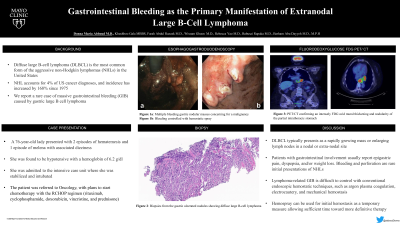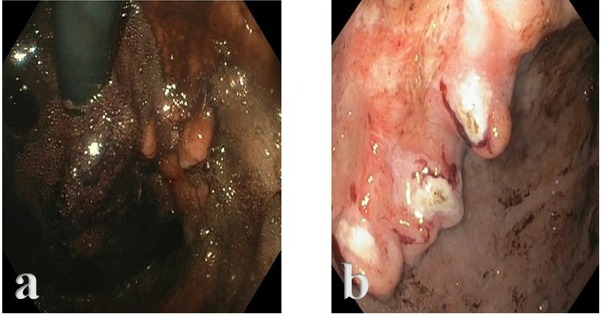Back


Poster Session B - Monday Morning
Category: GI Bleeding
B0336 - Gastrointestinal Bleeding as the Primary Manifestation of Extranodal Large B-Cell Lymphoma
Monday, October 24, 2022
10:00 AM – 12:00 PM ET
Location: Crown Ballroom

Has Audio

Donna Maria Abboud, MD
Mayo Clinic
Rochester, MN
Presenting Author(s)
Donna Maria Abboud, MD, Khushboo S. Gala, MD, Farah Abdul Razzak, MD, Wissam Ghusn, MD, Rebecca Yao, MD, MPH, Babusai Rapaka, MD, Barham Abu Dayyeh, MD, MPH
Mayo Clinic, Rochester, MN
Introduction: Diffuse large B-cell lymphoma (DLBCL) is the most common form of aggressive non-Hodgkin lymphomas (NHLs) in the United States. NHL accounts for 4% of US cancer diagnoses, and incidence has increased by 168% since 1975. We report a rare case of massive GI bleeding caused by gastric large B cell lymphoma.
Case Description/Methods: A 76-year-old lady, with a past medical history significant for breast cancer status post right mastectomy and chemoradiation, presented to the emergency department with 2 episodes of hematemesis and 1 episode of melena with associated dizziness. She was found to be hypotensive with a hemoglobin of 6.2 g/dl. She was admitted to the intensive care unit where she was stabilized and intubated. The patient underwent an esophagogastroduodenoscopy which showed multiple bleeding gastric nodular masses, controlled with hemostatic spray. The biopsy indicated a large B cell lymphoma with IRF4 rearrangement with no MYC/IGH fusion and no rearrangement of MYC, BCL2, or BCL6. A fluorodeoxyglucose (FDG) PET/CT confirmed an intensely FDG avid mural thickening and nodularity of the partial intrathoracic stomach consistent with gastric DLBCL. On bone marrow biopsy, no morphologic features of involvement by lymphoma were noted. The patient was referred to Oncology, with plans to start chemotherapy with the RCHOP regimen (rituximab, cyclophosphamide, doxorubicin, vincristine, and prednisone).
Discussion: DLBCL is the most common lymphoma, accounting for about 25% to 30% of all the NHLs. It typically presents as a rapidly growing mass or enlarging lymph nodes in a nodal or extra-nodal site. Patients with gastrointestinal (GI) involvement usually report epigastric pain, dyspepsia, and/or weight loss for a duration ranging between a few weeks to several years. Bleeding and perforation are rare initial presentations or accompanying symptoms of NHLs. Nonetheless, massive GI bleeding can increase the morbidity and mortality risk of DLBCLs.
Lymphoma-related GI bleeding is difficult to control with conventional endoscopic hemostatic techniques, such as argon plasma coagulation, electrocautery, and mechanical hemostasis.
Hemospray can be used for initial hemostasis in high-risk cases as a temporary measure allowing sufficient time toward more definitive therapy.

Disclosures:
Donna Maria Abboud, MD, Khushboo S. Gala, MD, Farah Abdul Razzak, MD, Wissam Ghusn, MD, Rebecca Yao, MD, MPH, Babusai Rapaka, MD, Barham Abu Dayyeh, MD, MPH. B0336 - Gastrointestinal Bleeding as the Primary Manifestation of Extranodal Large B-Cell Lymphoma, ACG 2022 Annual Scientific Meeting Abstracts. Charlotte, NC: American College of Gastroenterology.
Mayo Clinic, Rochester, MN
Introduction: Diffuse large B-cell lymphoma (DLBCL) is the most common form of aggressive non-Hodgkin lymphomas (NHLs) in the United States. NHL accounts for 4% of US cancer diagnoses, and incidence has increased by 168% since 1975. We report a rare case of massive GI bleeding caused by gastric large B cell lymphoma.
Case Description/Methods: A 76-year-old lady, with a past medical history significant for breast cancer status post right mastectomy and chemoradiation, presented to the emergency department with 2 episodes of hematemesis and 1 episode of melena with associated dizziness. She was found to be hypotensive with a hemoglobin of 6.2 g/dl. She was admitted to the intensive care unit where she was stabilized and intubated. The patient underwent an esophagogastroduodenoscopy which showed multiple bleeding gastric nodular masses, controlled with hemostatic spray. The biopsy indicated a large B cell lymphoma with IRF4 rearrangement with no MYC/IGH fusion and no rearrangement of MYC, BCL2, or BCL6. A fluorodeoxyglucose (FDG) PET/CT confirmed an intensely FDG avid mural thickening and nodularity of the partial intrathoracic stomach consistent with gastric DLBCL. On bone marrow biopsy, no morphologic features of involvement by lymphoma were noted. The patient was referred to Oncology, with plans to start chemotherapy with the RCHOP regimen (rituximab, cyclophosphamide, doxorubicin, vincristine, and prednisone).
Discussion: DLBCL is the most common lymphoma, accounting for about 25% to 30% of all the NHLs. It typically presents as a rapidly growing mass or enlarging lymph nodes in a nodal or extra-nodal site. Patients with gastrointestinal (GI) involvement usually report epigastric pain, dyspepsia, and/or weight loss for a duration ranging between a few weeks to several years. Bleeding and perforation are rare initial presentations or accompanying symptoms of NHLs. Nonetheless, massive GI bleeding can increase the morbidity and mortality risk of DLBCLs.
Lymphoma-related GI bleeding is difficult to control with conventional endoscopic hemostatic techniques, such as argon plasma coagulation, electrocautery, and mechanical hemostasis.
Hemospray can be used for initial hemostasis in high-risk cases as a temporary measure allowing sufficient time toward more definitive therapy.

Figure: Figure 1a: Multiple bleeding gastric nodular masses concerning for a malignancy
Figure 1b: Bleeding controlled with a hemostatic spray
Figure 1b: Bleeding controlled with a hemostatic spray
Disclosures:
Donna Maria Abboud indicated no relevant financial relationships.
Khushboo Gala indicated no relevant financial relationships.
Farah Abdul Razzak indicated no relevant financial relationships.
Wissam Ghusn indicated no relevant financial relationships.
Rebecca Yao indicated no relevant financial relationships.
Babusai Rapaka indicated no relevant financial relationships.
Barham Abu Dayyeh: Apollo Endosurgery – Grant/Research Support. Aspire Bariatrics – Grant/Research Support. BFKW – Consultant. Boston Scientific – Consultant, Grant/Research Support. Cairn Diagnostics – Grant/Research Support. DyaMx – Consultant. Endogastric Solutions, – Speakers Bureau. Endo-TAGSS – Consultant. GI Dynamics – Grant/Research Support. Johnson and Johnson – Speakers Bureau. Medtronic; – Grant/Research Support. Metamodix – Consultant. Olympus – Speakers Bureau. Spatz Medical – Grant/Research Support. USGI Medical – Consultant, Grant/Research Support.
Donna Maria Abboud, MD, Khushboo S. Gala, MD, Farah Abdul Razzak, MD, Wissam Ghusn, MD, Rebecca Yao, MD, MPH, Babusai Rapaka, MD, Barham Abu Dayyeh, MD, MPH. B0336 - Gastrointestinal Bleeding as the Primary Manifestation of Extranodal Large B-Cell Lymphoma, ACG 2022 Annual Scientific Meeting Abstracts. Charlotte, NC: American College of Gastroenterology.
